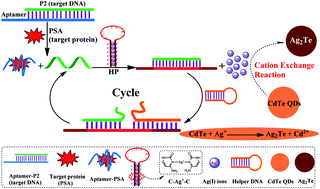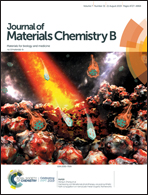Selective recognition of CdTe QDs and strand displacement signal amplification-assisted label-free and homogeneous fluorescence assay of nucleic acid and protein†
Abstract
Due to their simplicity of design and operation, homogeneous bioassays have been of great interest to researchers. Herein, a label-free and free separation fluorescence sensing platform was constructed for the determination of nucleic acid and prostate specific antigen (PSA) using CdTe QDs as the signal molecule. In our previous work, we surprisingly found that the CdTe QDs can selectively distinguish Ag+ and the C–Ag+–C complex, which was the basis of the sensor. On the basis of the selective cation exchange reaction (CER), combined with the signal amplification of the strand displacement reaction (SDR), this work was first applied for the sensitive analysis of DNA. There are two types of hairpin structures in this sensing system, including the recognition probe (HP) and Ag+, which formed the C–Ag+–C structure, and the hairpin structure formed by the helper DNA itself. In this work, target DNA can trigger the SDR that generates lots of HP-helper double-stranded DNA (dsDNA) and recycles the target DNA while releasing a large amount of Ag+, thus quenching the fluorescence signal of CdTe QDs to achieve the highly sensitive detection of DNA. In order to verify the versatility of this system using DNA as a bridge and aptamers as recognition probes, we extended the system to the detection of PSA. After examining its experimental performance, it was determined that this method displayed good analytical capability for DNA in the range of 10−13–10−10 M and PSA in the range of 10−13–10−10 g mL−1 with low 25 fM and 30 fg mL−1 limits of detection (LODs), respectively; high selectivity for both the target sequence and protein was shown. In addition, this platform was successfully used for the analysis of PSA in serum samples.



 Please wait while we load your content...
Please wait while we load your content...